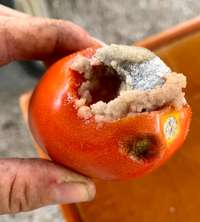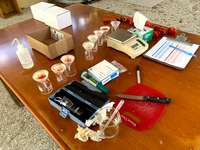Keywords: tomato preservation, storage, preservation, ripening
Abstract. Following the astonishing findings in an article published in November 2016 of a farmer preserving freshly harvested tomatoes in wood ash for up to 5 to 6 months, the research team at ECHO Florida decided to further investigate the potential of this technique to prolong the storage life of fresh tomatoes. We assumed that, in comparison to a control treatment of sifted sand, wood ash would extend the time over which tomatoes can be marketed or processed. To test this hypothesis, a randomized complete block design was used with tomatoes placed in boxes (4 tomatoes per box) filled with wood ash or sand. At the start of the trial, tomatoes were already ripe but unspoiled. Data were collected biweekly for tomato sugar content, visual quality, pH and carbon dioxide production. Differences in the measured parameters, between ash and sand, were not statistically significant. We were only able to preserve our tomatoes for 6 weeks. Differences between our findings and what the farmer was able to achieve could be related to ripening stage or source of wood ash. Future work could be done with tomato fruit at early (mature with slight change in color from green to red) versus more advanced stages of ripeness and with wood ash from various species of trees.
Introduction
In 2020, one of the ECHO interns, Michelle Boutell, shared a fabulous article with the team at Echo Florida entitled: Burundi: Farmer finds new technique for preserving tomatoes (Solanum lycopersicum). In this article, the farmer, Vital Nduwimana, explained how he was able to preserve freshly harvested tomatoes stored in ash for five to six months, allowing him to supply the market with off-season tomatoes which made his business very profitable.
As we’re all aware of, in the Global South, preserving perishable goods (fruits and vegetables) such as tomatoes is a tremendous challenge for small-scale farmers. The longest those products can last is a couple of days to a few weeks before they begin to decay. Farmers only have two options to get around this challenge:
- Quick sell at a bargain price
- Food processing (transformation)
Those strategies come with their own consequences as selling at a bargain usually is not profitable for the farmers, and not all of them have the skills and equipment required to transform (by drying, for example) their products. Therefore, the post-harvest losses (both in terms of yields and income) can be very significant.
Passionate about a finding such as Vital’s, we at ECHO decided to investigate his technique to observe the effect that ash has on tomato fruit quality over time. Specifically, we were interested in finding out about the potential of wood ash to extend marketability of fruits for:
- Fresh sale: How long will ash preserve the visual quality of fresh tomato fruit?
- Further processing: How long will ash preserve the quality of the inner flesh, for purposes of further processing (e.g., to make tomato paste), even after the visual quality of the fruit declines.
We hypothesized that tomatoes stored in wood ash have better postharvest outcomes and longer shelf life than tomatoes stored over the same period in sifted sand. If proven to work as expected, storing tomatoes in wood ash would be a worthwhile practice to share with farmers wanting to prolong the period of time over which they can sell their tomatoes.
Methods

Figure 1. Storage room temperature (F) and humidity (%) over time. Source: Rocheteau Dareus
To run the experiment, we purchased fresh, already-ripened Roma tomatoes. Those tomatoes were randomly placed, using a randomized complete block design, in boxes filled either with wood ash (treatment) or sifted sand (control) and placed in a room at ambient conditions (Figure 1). Sand was used as a control treatment to assess whether or not it matters what material is used to cover the tomatoes.
Preliminary data were collected, using eight tomatoes, as a baseline for the following parameters (Figure 2):
- Sugar content (BRIX)
- Visual quality (Scale of 0 to 5 with 0 being poor visual quality and 5 being excellent)
- Tomato pH
- Carbon dioxide production.

Figure 2. Labeled boxes of Roma tomatoes arranged randomly on a table under the shelter of a screened porch. Source: Stacy Swartz
We intended to collect these data on a biweekly basis for a period of 6 months (or until the tomatoes were unmarketable) using two boxes of tomatoes (one box of tomatoes stored in wood ash and one box of tomatoes stored in sifted sand) per sampling (Figure 2). Thus, the experiment was set up with a total of 24 boxes (12 boxes per treatment), with four tomatoes per box. However, since the tomatoes ripened and decayed at a faster-than-expected rate, data were collected for only four boxes of tomato over a period of 1.5 months; data for the first two batches were collected on a biweekly basis, and data for the last two batches were collected on a weekly basis (Figure 4). Collected data were analyzed using R software to determine whether there were any statistically significant differences among tomatoes stored in boxes filled with wood ash versus those stored in boxes filled with sifted sand over time.

Figure 3. View of a session of data collection for all five parameters and the equipment used. Source: Stacy Swartz
A HOBO® temperature and humidity logger device was used to track the temperature and humidity levels of the ambient environment (screened room) during the duration of the experiment.
Results
Temperature and humidity levels fluctuated broadly during the experiment with average respective values of 80.55 F and 67.03% (Figure 1).

Figure 4. View of a tomato at an advanced decaying stage just within two weeks of storage in a box filled with sand. Source: Stacy Swartz
Each time the tomatoes were sampled, there were no statistically significant differences between the tomatoes in the ash versus those in sand. This was true for all of the parameters measured (Figure 5). Statistically, it was a challenge to test for response to time. Visually, though, when you look at the graphs, there are what appear to be clear patterns over time. For instance, pH steadily increased while sugar steadily decreased over time. Although the differences were not statistically different, tomatoes kept in sand released more carbon dioxide than those kept in ash. Fruits release more carbon dioxide as they ripen and decay, so this result suggests a positive effect of ash in slowing the ripening/decaying of tomatoes.
However, the sugar content and pH were higher in tomatoes stored in ash compared to those stored in sand over time (Figure 5b and 5c). A high sugar content (sweetness) and pH in a fruit closely relates to an increase of metabolic activity (degradation of starches into simpler saccharides: glucose) associated with fruit ripening and decay. By the last sampling there was no difference in visual ratings between tomatoes stored in ash versus sand (Figure 5d).

Figure 5. Bar plots showing fluctuation over time, in ash versus sand, of: a) carbon dioxide emitted by the tomatoes b) pH of juice in the tomato flesh c) tomato sugar content d) visual quality of the tomatoes. Letters on top of the error bars express the statistical significance among the treatments over time. Source: Rocheteau Dareus
Conclusion
Overall, no solid conclusion in terms of performance of the treatments could be drawn from the results. It was not clear why storage in ash seemed to slow ripening decay in terms of carbon dioxide release but not with respect to sugar and pH levels. The results did not meet our expectations/hypothesis since there were no statistical differences in the parameters of tomatoes stored in ash versus those stored in sand over time. Our findings differ largely from those of Vital’s with regards to expected storage life using ash. The tomatoes in this study lasted for six weeks while Vital reported storing his for 5 to 6 months. However, some underlying preexisting conditions may have been the cause of such a short amount of time in our experiment:
- We used tomatoes that were already ripened
- The ranges of temperature and humidity (Figure 1) in the room were suitable to rapid tomato ripening.
Vital’s findings can be investigated further. Below are some of our suggestions for further related research:
- Use fresh tomatoes from the field, harvested at an early stage of ripeness (e.g., after slight color change from green to red), rather than ripened ones from supermarkets shelves.
- Use different sources of ash (e.g., with known species of trees), as ash’s mineral constituents (proportions) can be a key factor in delaying tomato ripening.
Cite as:
Dareus, R. 2022. Does Wood Ash Help Preserve Tomatoes (Solanum lycopersicum)? ECHO Research Note 2(6).